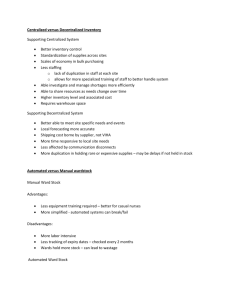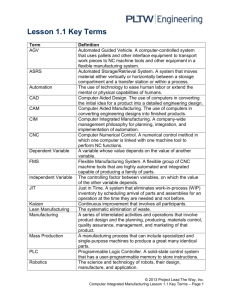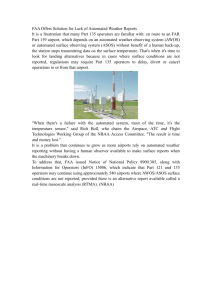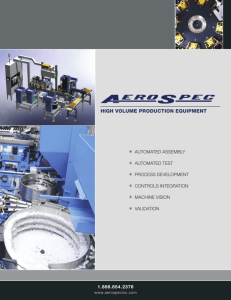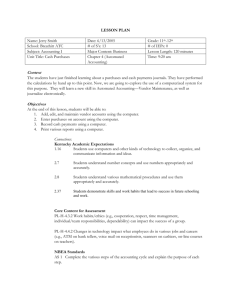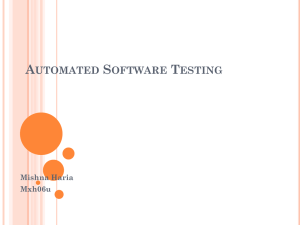Decision Evolution
advertisement
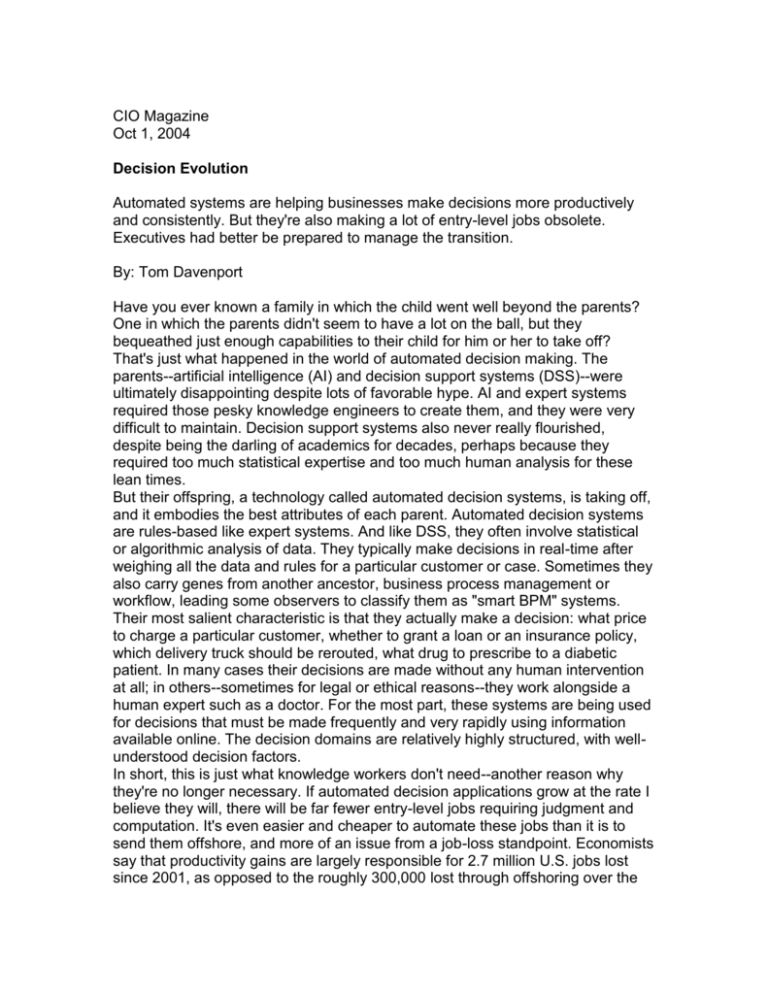
CIO Magazine Oct 1, 2004 Decision Evolution Automated systems are helping businesses make decisions more productively and consistently. But they're also making a lot of entry-level jobs obsolete. Executives had better be prepared to manage the transition. By: Tom Davenport Have you ever known a family in which the child went well beyond the parents? One in which the parents didn't seem to have a lot on the ball, but they bequeathed just enough capabilities to their child for him or her to take off? That's just what happened in the world of automated decision making. The parents--artificial intelligence (AI) and decision support systems (DSS)--were ultimately disappointing despite lots of favorable hype. AI and expert systems required those pesky knowledge engineers to create them, and they were very difficult to maintain. Decision support systems also never really flourished, despite being the darling of academics for decades, perhaps because they required too much statistical expertise and too much human analysis for these lean times. But their offspring, a technology called automated decision systems, is taking off, and it embodies the best attributes of each parent. Automated decision systems are rules-based like expert systems. And like DSS, they often involve statistical or algorithmic analysis of data. They typically make decisions in real-time after weighing all the data and rules for a particular customer or case. Sometimes they also carry genes from another ancestor, business process management or workflow, leading some observers to classify them as "smart BPM" systems. Their most salient characteristic is that they actually make a decision: what price to charge a particular customer, whether to grant a loan or an insurance policy, which delivery truck should be rerouted, what drug to prescribe to a diabetic patient. In many cases their decisions are made without any human intervention at all; in others--sometimes for legal or ethical reasons--they work alongside a human expert such as a doctor. For the most part, these systems are being used for decisions that must be made frequently and very rapidly using information available online. The decision domains are relatively highly structured, with wellunderstood decision factors. In short, this is just what knowledge workers don't need--another reason why they're no longer necessary. If automated decision applications grow at the rate I believe they will, there will be far fewer entry-level jobs requiring judgment and computation. It's even easier and cheaper to automate these jobs than it is to send them offshore, and more of an issue from a job-loss standpoint. Economists say that productivity gains are largely responsible for 2.7 million U.S. jobs lost since 2001, as opposed to the roughly 300,000 lost through offshoring over the past three years. I've even heard of one company that is using Indian programmers and statisticians to develop its automated decision systems--a double whammy for the American knowledge worker. These systems are being used across a variety of industries and decision types, as my former Accenture colleague Jeanne Harris and I found after a year of research. They are more real-time, more complex and much more pervasive than the original versions: yield management systems in airlines that made seat pricing decisions in the early '80s. In airlines, for example, the technology has now been extended to a variety of operations issues, including flight scheduling and crew and airport staff scheduling. Yield management is also being combined with loyalty management applications to determine real-time pricing for hotel rooms. Casino operator Harrah's Entertainment, for example, makes several million dollars a month in incremental revenue by optimizing room rates for its hotels and offering different rates to different levels of members in its loyalty programs. Although automated decision systems are common in travel and transportation, financial services is using this technology to the greatest degree. In banking, real-time mortgages and secured lending decisions are becoming common. For example, LendingTree.com uses automated decision making for two purposes: first, to decide which of its participating banks are most likely to issue a mortgage to a customer. Second, to actually offer four mortgage deals within a few minutes to a customer, using the banks' technology or its own. DeepGreen Bank was designed from the ground up around automated decision technology for home equity loans. Customers can complete an application (including reported income) within five minutes, and an automated process swings into action. The system pulls a credit report, invokes a scoring algorithm, accesses an online valuation of the property, checks fraud and flood insurance, and then makes a loan decision. About 80 percent of the time the customer receives a final decision within two minutes. The system automatically selects a local notary, and the customer completes the process by choosing a closing date. One of the first industries to adopt automated decision-making approaches was insurance, which has been exploring automated underwriting applications for over a decade. The industry was also an early adopter of artificial intelligence and expert systems, but those efforts (mostly in the 1980s) did not pay off. Now, however, the use of rules-based technology in underwriting has become pervasive in large insurers' personal-lines businesses, and it is penetrating the more complex processes of small-business underwriting. There have also been some efforts to automate decision making in other insurance processes, including claims, but adoption in these areas has been slower. Other industries are using automated decision making to do a variety of tasks, including: Intelligent ordering and treatment protocols in health care, Pricing and matching of demand and supply in electronics and automobiles, Supply chain optimization, Call center scripting, Extension of business credit and financing, Review of credit portfolios, IT system configuration. Technology Environment Although automated decision making is becoming a mainstream business activity, the technologies and vendors that support it are still relatively small scale. Most organizations use "business rules" technologies that are available from a few small vendors, such as Ilog, Fair Isaac and PegaSystems. Some industries, such as insurance, have industry-specific packages available for tasks such as underwriting, which can shorten the time to implementation. Most organizations, however, develop their own custom systems. The technologies involved include a rule language, a rule builder and development environment, a rule editor and a rule repository. Rules are often embedded within other applications, such as an insurance underwriting workflow system. One major difference between current technology and its AI parent is that end users or managers generally maintain the rule base, rather than technologists. In insurance, for example, IT people and consultants often work with underwriting experts to create an initial rule base, but ongoing management and creation of new rules is typically done by the underwriters themselves. The goal is not just to establish a rule base but to optimize it. If the system has been operating for some time and there is sufficient data, it's possible to understand the contribution of each individual rule to profitability or some operational measure and then optimize the system by taking out rules that don't add value. Management Issues One of the greatest challenges for managers of these systems is finding a sufficient number of experts to both create the system (this typically requires several full-time experts for several months) and optimize it. One manager of a project for small business insurance, for example, had to unplug systems for some policy lines because he didn't have sufficient experts on staff to tune the system and optimize the rules. He could use either underwriting experts or actuaries for this purpose, but neither were available in sufficient numbers. While experts may be in high demand and short supply, lower-level contributors aren't as necessary anymore. Although we heard of no large-scale layoffs resulting from these systems in our research, one might assume such positions will be filled less often in the future. Managers need to think about how experts will be developed over time without lower-level jobs to feed these positions. When experts retire or leave the company, where will the next set of experts come from? From a change management standpoint, managers need to communicate as early as possible what will happen to jobs, how decision making will be automated and centralized, and what decisions people will make versus the system. Even experts may have issues with the change, since they'll deal with exceptions and hard cases all the time, rather than just occasionally. This brave new world has been a long time in coming, but it is clearly upon us now. Businesses need to incorporate automated decision making into their strategies and processes or they won't be successful for long. There is simply too much data, and too many decisions to be made on it, for organizations to pass on this technology. Some jobs may be lost, but firms that improve their productivity in this manner will at least remain in business. Tom Davenport is professor of IT and management at Babson College and an Accenture Fellow. You can reach him at tdavenport@babson.edu.




